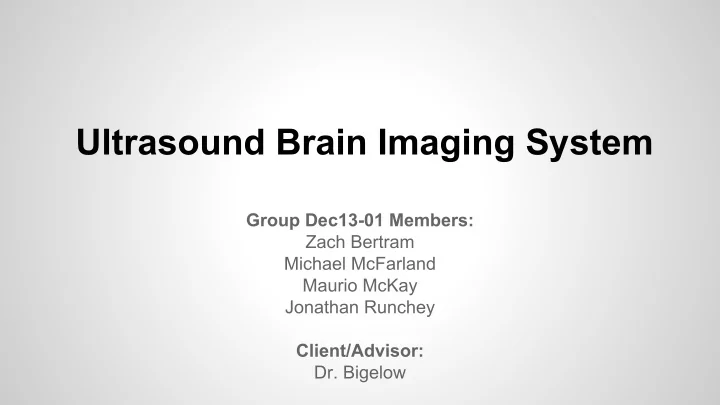

Ultrasound Brain Imaging System Group Dec13-01 Members: Zach Bertram Michael McFarland Maurio McKay Jonathan Runchey Client/Advisor: Dr. Bigelow
Project Overview ● Pulse Echo Ultrasound for brain imaging ● Cheap and portable alternative to fMRI ● Ability to send pulses over 512 channels ● Ability to increase gain to view different regions of the brain ● Viewable image from PC
Our Mission ● 8 channel transmit/receive PCB ● Interfaceable with NI PXI system ● Usable with transducer ● Scalable to 512 channels
Functional Requirement ● Generate 1 MHz pulses ● Send +/-50 V pulses to transducer ● Transmit : 8 channels ● Receive : 8 channels ● LNA gain of 40 dB ● Protection circuit that limits output voltage to 2 Vpp
Nonfunctional Requirements ● Board size below 60 in 2 ○ In order to reduce cost ○ To reduce complexity ● Well documented PCB design ○ For easier troubleshooting and repair
Challenges ● No previous experience soldering high pin density SMT parts ● High individual IC costs ● No previous PCB design experience
National Instruments System ● Will be computer interface for system ● Not yet ordered NI PXI-7811R NI 5752 18 Slot NI PXI Chassis
Beamformer(LM96570) ● Provides a serial interface to control the high voltage pulser ● Reduces required Input channels to control pulser from 18 to 9
High Voltage Pulser(LM96550) ● Controlled by the Beamformer ● Sends +/-50 V pulses to transducer
T/R switch(TX810) ● Protects receive circuitry from 50 V pulses ● Output voltage limited to 2 Vpp
Transducer ● 512 Linear Array ● Converts high voltage pulses(+/-50 V) to ultrasonic waves to transmit into body
Low Noise Amplifier(LMH6622) ● High Gain Bandwidth (160 MHz) Low noise floor (1.6 nV-Hz -1/2 ) ●
Op Amp Protection Circuit ● Limit output voltage to 2 Vpp ● Lets signals under 2 Vpp pass unattenuated
NI-5752 Module ● 32 Analog receive channels ● Contains TI-AFE5801 analog front end ○ Variable gain range -5 dB-31dB ○ 12-bit A/D converter ● Max input 2 Vpp
Protection Circuit ● At the start of this semester our client requested we make a protection circuit ○ To protect the NI-5752 module ■ Limits voltage to 2 Vpp
Protection Circuit Solution ● Decided to use the following bounding circuit:
Protection Circuit Challenges ● Difficulties in analysis of the circuit ● Unexpected behavior in simulation ○ Resolved by reducing diode capacitance ○ Added a capacitor to bypass diode at high frequencies
Protection Circuit
Simulation Results: Non-Working Model ● Input 5 Vpp ● Output exceeds 2 Vpp
Simulation Results: Working Model ● Input of 5 Vpp ● Output never exceeds 2 Vpp
Final Board Layout
PCB soldering ● PCB was ordered with solder mask ● Consulted with electronics tech on how to solder a parts heavy board
PCB soldering ● Board soldered with a preset oven profile and tested
PCB Soldering Challenges ● Challenge ○ LNA, HVP, Beamformer pins were bridged due to high pin density ● Solution ○ Removed by hand with solder wick ○ Increased size of pads for 2nd and 3rd boards
Soldered Test Board
Test Plan ● Start testing 8-channel board ● Testing order: ○ LNA circuit ■ Check for correct gain (40 dB) ■ Verify that the noise level is acceptable ○ Protection Circuit ■ Make sure it limits the output voltage of the LNAs to below 2 Vpp ○ Tx810 ■ Make sure the device limits the voltage at its output to 2 Vpp ○ LM96550(HVP) ■ Check that we are able to send a pulse to the SMA pins ○ LM96570 ■ Unable to be tested this semester ● requires NI-PXI system
Test Results Revision 1 PCB: LNA ● LNAs gave unexpected output: ○ Expecting a Gain of 10 V/V ○ First Stage gave an attenuated sine wave output ○ Second stage gave no output
LNA Breadboard Test ● Decided to test on breadboard using test PCB ○ Switched to non-inverting configuration at clients request ● Able to get proper signal on breadboard with a gain of 10 V/V for each stage for the new non-inverting design. ● Input Voltage: 20 mVpp Output voltage: 2.26 Vpp
Test Results Revision 2 PCB: LNA ● LNA tests for non-inverting output: ○ Expecting a Gain of 10 V/V ○ No signal at first stage output ■ Upon further investigation found a DC output of -4.07 V ○ No signal at second stage output ■ Same -4.07 V DC output ● Same for all LNAs on the second revision boards ○ Conclusion: error with PCB or soldering procedure
Test Results Revision 1 PCB : TX810 ● Worked as expected ○ Limited peak to peak voltage output to 2 V ○ Output waveform retained amplitude for lower voltages ○ Small distortion ○ Output waveform had lost small phase change ● Tx810 burned while trying to test the LNA circuit ○ Most probable cause is a short circuit while trying to resolder and test the LNAs ○ Unable to obtain pictures before we burned the device
Test Results: TX810 ● Second stage of testing resulted in proper waveform output. 200mv input wave at 1 MHz
Test Results: TX810 ● Successfully working TX810 5v Wave attenuated to ~2 Vpp at 1 MHz
Test Results: LM96550 (High Voltage Pulser) ● Testing of HVP stopped due to chip damages ● All 3 testing phases resulted in burnt chip ● Potential reasons for damage: ○ Unknown PCB error ○ Improper soldering ○ Improper start up sequence
Q & A
Budget for both semesters
Test Board PCB
Recommend
More recommend